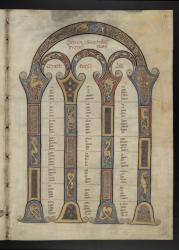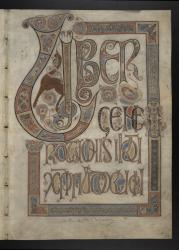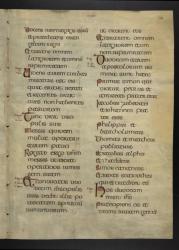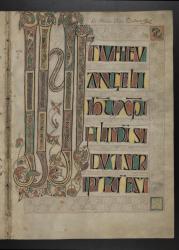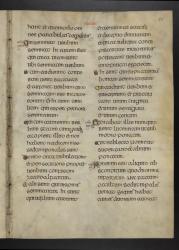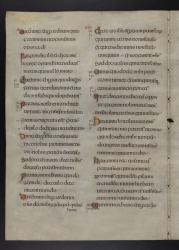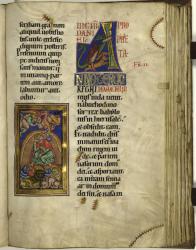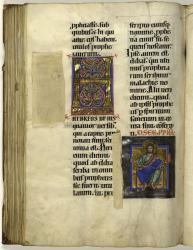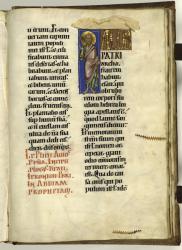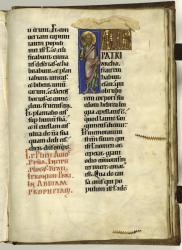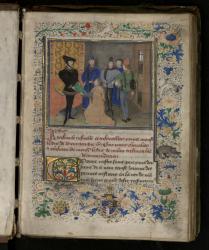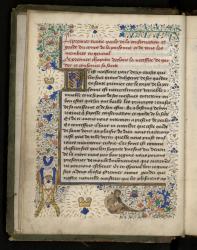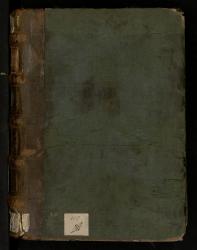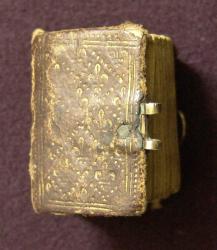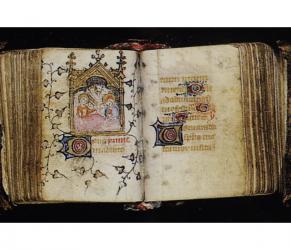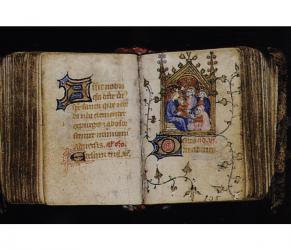Western Manuscripts
The National Library's collection of Western manuscripts and autograph documents has no equal in Russia. It contains about 6,000 handwritten books and more than 70,000 documents dated from the 5th to 20th centuries. The collection covers Latin, French, German, Spanish, Italian and other European languages. Petersburg's holdings include material of distinguished importance for all periods, all West-European countries, and especially for France.
The history of the national repository of manuscripts and private papers and archives in West-European languages began with the outstanding collection of Piotr Dubrovsky (1754-1816). He amassed the items at the latter part of the 18th century while serving as the secretary and interpreter with the Russian Embassy at Paris. The collection had arrived in Petersburg even before the Imperial Public Library was open. The second notable collection of Count Pieter van Suchtelen (1751-1836), the Russian ambassador at Sweden, was purchased in 1836. Both collections held manuscript books and extensive documental material ranging from early Middle Ages to the first quarter of the 19th century. They passed into the founding collection of the Imperial Public Library.
The collection began to expand rapidly. It was further augmented by the manuscripts from the private royal library, founded by Catherine II, which was also known as the Hermitage collection. After 1917 individual manuscripts came in from the royal suburban palaces at Pavlovsk and Peterhof and the town palaces of Stroganov and Yusupov families. The documental part of this repository was increased with numerous foreign autographs. Most of them (about 3000 items) were added at the acquisition of P.L. Vaksel-E.P. Yurgenson's collection in 1919.
Medieval Manuscripts from the 5th-15th Centuries
The National Library of Russia is especially fortunate in possessing medieval manuscript books of the 5th-15th centuries. The group of antiquarian Latin copies is the most remarkable among them. These copies were created in the scriptoria of West-European monasteries during early Middle Ages. The history of the 36 manuscripts, for the period before 830, is closely connected with the history of the celebrated monastery Сorbei, which had been found in the 7th century in the northwest of the frank's country (the north of contemporary France). In the majority of cases, these manuscripts were created in the Сorbei's scriptorium, but there are some of them, which came to the monastery's library after long travells.Among the latter is the Collected Works of Saint Augustine (died in 430), the oldest Latin manuscript in possession of the National Library of Russia. Scientists consider the copy to be created during the 5th century in Hippo, small Northern African town, where Saint Augustine was ordained bishop. It is quite possible that at the end this text bears the actual autograph of Saint Augustine.
No less unique is the Ecclesiastical History of the English People by the first English historian, the Venerable Bede (died in 735), a monk of Jarrow Monastery in Ancient Northumbria (the north-eastern England). The remarkable historical manuscript is often called Leningrad Bede in scientific literature. This second oldest surviving copy was created near 746, only 10 years after the death of the author. For the first time in the history of the West European book illustration, its decoration includes a new element, the "historiated" initial letter that contains a picture.
The illuminated manuscripts, from the 12th to the first third of the 16th centuries, form the most celebrated and valuable part of the Petersburg's collection. Undoubtedly, more than a half of them are secular copies, such as historical chronicles, novels and scholarly treatises, translations of antique authors, but they also include Biblical and liturgical manuscripts (Psalters, Books of Hours etc.).A set of magnificent manuscripts demonstrate the manner of artistic decoration in Italy, Spain, Germany, Netherlands. The majority has come from the libraries of French kings or other members of the royal family, great nobles and officers of state. Naturally, manuscript books produced for kings and great aristocrats were written and decorated by the finest calligraphers and artists of the age.
Experts regard the illumination of so-called 'Bible Historiale' to be a brilliant example of early fourteenth century Parisian work. In the 13th century the canonic Guiart des Moulins produced this free French translation of the Petrus Comestorus's Scholastic History from Latin. This two folio volumes belonged to the d'Albrets, the house of Navarre, therefore, the blank pages and covers bear the signatures of many members this family, including Henry IV and his wife Margaret of Angouleme, "Queen Margo".
The most famous prayer-book was given to Mary, Queen of Scots by her uncle, the Duc de Guise, when she was still betrothed to the Dauphin, the future Frances II. It was created and beautifully illuminated in France in the second quarter of the 15th century. On blank pages and on the margins there are many notes, written by Mary herself. It is said that she took this very book to the scaffold with her.But the undeniable masterpiece of book illumination in the Library's holdings is the 15th century manuscript Grandes Chroniques de France. It was created in 1455-1457 for the Duke of Burgundy, Philip the Good, who vied with the French king for wealth and power. The huge volume is decorated with 90 miniatures. 11 of them are paintings by the outstanding artist of the age, Simon Marmion, who his contemporaries called the Prince of Miniaturists.
Apart from its unique medieval codices, the Library collection also contains extensive documentary material of that period. There are deeds of Germanic emperors, French and Spanish kings; papal bulls; acts relating to monastic lands; financial reports about the collection of taxs and the construction of fortifications during the Hundred Year War; official and private correspondence. The earliest surviving medieval documents of the Library's holdings are the papers of Inda Monastery (Cornelismunster), dating between 866 and 997.
Modern Historical Manuscripts from the 16th-20th Centuries
Some manuscripts of the 16th-17th centuries represent the unique presentation copies. Among them there are books intended for King of Poland, Henri de Valois (later King Henry III of France) and the Chancellor of France, Pierre Seguier.
Other important manuscripts contain writers' autographs and fair copies, including works that are still remained to be published. Notable authorized copies of Denis Diderot's complete works (32 volumes), produced by author's request for Empress Catherine II, provide valuable resources for the study of his Literary Legacy. They arrived at Saint Petersburg along with Diderot's library.
The Western repository include sets of material, from 16th-18th centuries, which are exeptional historical importance. The greater part of the documens has come from France and represents a "goldmine" for reseachers into that country's history. Most of them (more than 7,000 documents) consists of the state papers of the 16th-17th centuries. These are official royal letters( over 200 by Charles II,350 by Henry III, 255 by Catherine de' Medici and so on), letters from state and army officials, reports by officers of the law courts, municipalities and provincial estates of France and also despatches from ambassadors to various European countries; part of the chancellor Pierre Seguier's archive (more than 1,400 documents in all).
Alongside the autographs of Voltaire, Diderot, Rousseau, Marmontel, Buffon, the 18th century is represented by documents of the last decades of Louis XIV's reign, by the papers from the archives of the Bastille.
From the time of the French Revolution the library has original papers in the handwriting of Robespierre, Danton, Saint-Just etc., as well as official documents signed by members of Convention, the Committee of Public Savety and the Directory.
Documents on the history of other Western European countries: England, Denmark, Sweden, Spain, the Netherlands, Poland and the Grand Duchy of Lithuania, various states of Germany and Italy of the 16th - 18th centuries also occupy a significant place in the collection of Western manuscripts of the Department. Treasures include material of indubitable interest to researchers into European cultural history from archives of German astronomer, mathematician, artist and engraver G.-Ch. Eimmart (1638-1705) as well as Venetian editor and philologist, Abbot A. Calogera (1699-1768).
The era of Napoleon is reflected in a large set of documents (about 14 thousand) from the archives of the Kingdom of Westphalia. It was created after the defeat of Prussia in the Franco-Prussian War of 1806 - 1807, according to the Peace of Tilsit. While formally independent, it was a part of the First French Empire until 1813. Napoleon's younger brother Jerome Bonaparte became king of Westphalia. The archive contains official documents signed by King Jerome Bonaparte, his secretary of state and heads of ministries (military, internal affairs, justice and others), as well as materials of military leaders and various administration officials, including the so-called Supreme Police.
The papers of statesmen, military officers, scientists, writers, artists from various European countries are important parts of the Library's holdings, particularly useful for the study of local modern history.
The materials on American history occupy the special place in the stock. Small, but remarkable collection includes approximately 100 documents of the 17th-20th centuries. Among them there are autographs of one of the founders of the United States Benjamin Franklin, and the first six American presidents: George Washington, John Adams, Thomas Jefferson, James Madison, James Monroe, John Quincy Adams.
Noteworthy are the cartographic materials housed in the Western Sector. The earliest image of this kind is a world map from a work by the 5th century Latin writer Macrobias, dated between the late 10th and early 11th century. The parchment depicts the globe, divided into five climatic zones, with four continents surrounded by oceans and seas. The Western holdings of the Manuscripts Department include five portolan nautical charts, the earliest of which is the Portolan Atlas by Battista Agnese of 1546.
See our virtual exhibitions:
History and Culture of Western Europe
Medieval European Literature
Dutch Manuscript Material in the NLR
German Manuscript Prayerbooks
First Collections of the Imperial Public Library: the Zaluski Manuscripts
View in the Digital Library the 15th century manuscripts:
Prayer Book of Mary, Queen of Scots (Mary I Stuart)
